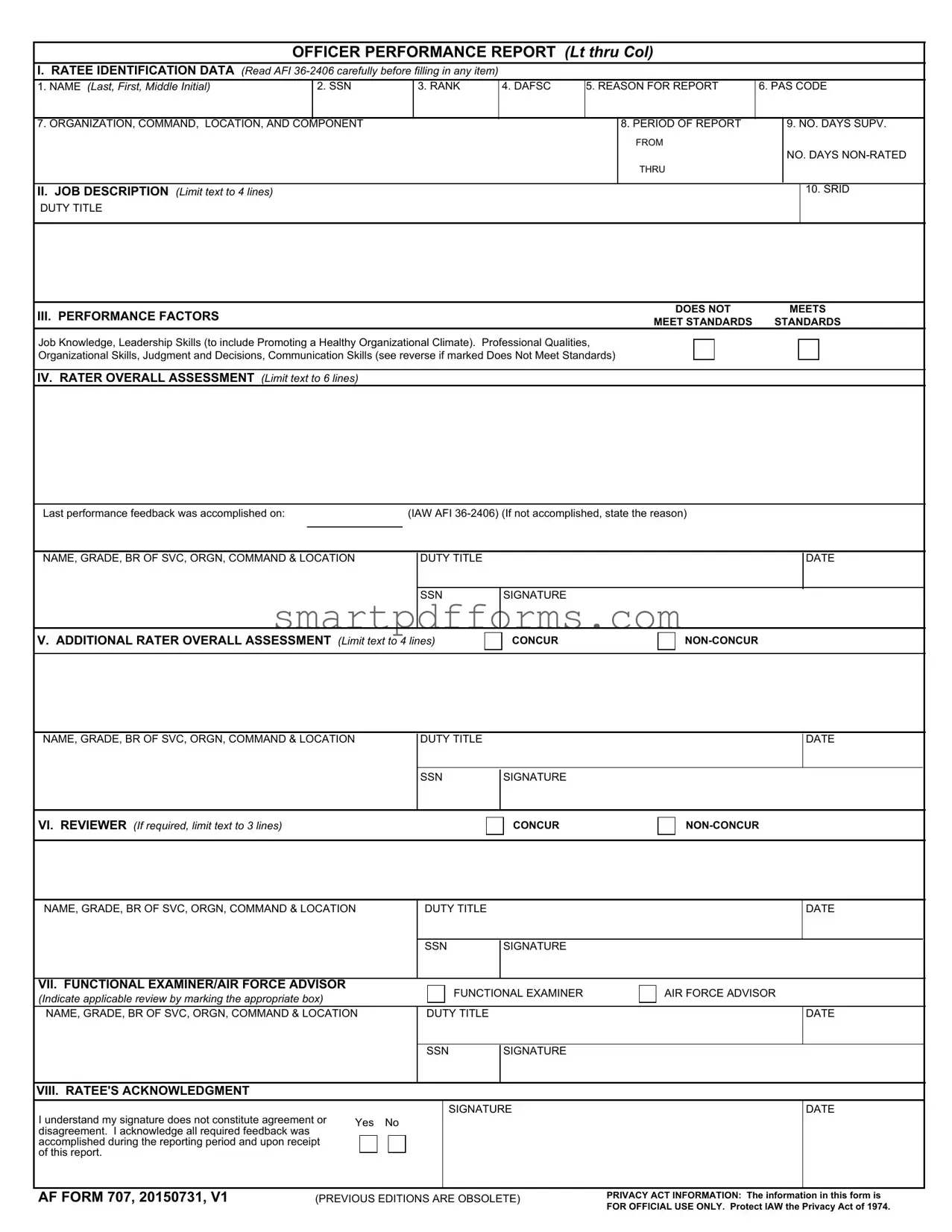OFFICER PERFORMANCE REPORT (LT THRU COL)
I. RATEE IDENTIFICATION DATA (Read AFI 36-2406 carefully before filling in any item)
1. NAME (Last, First, Middle Initial)
7. ORGANIZATION, COMMAND, LOCATION, AND COMPONENT
8.PERIOD OF REPORT
FROM
THRU
9.NO. DAYS SUPV.
NO. DAYS NON-RATED
II.JOB DESCRIPTION (Limit text to 4 lines)
DUTY TITLE
|
III. PERFORMANCE FACTORS |
DOES NOT |
MEETS |
|
MEET STANDARDS |
STANDARDS |
|
|
Job Knowledge, Leadership Skills (to include Promoting a Healthy Organizational Climate). Professional Qualities,
Organizational Skills, Judgment and Decisions, Communication Skills (see reverse if marked Does Not Meet Standards)
IV. RATER OVERALL ASSESSMENT (Limit text to 6 lines)
Last performance feedback was accomplished on: |
|
(IAW AFI 36-2406) (If not accomplished, state the reason) |
|
|
|
NAME, GRADE, BR OF SVC, ORGN, COMMAND & LOCATION
V. ADDITIONAL RATER OVERALL ASSESSMENT (Limit text to 4 lines)
NAME, GRADE, BR OF SVC, ORGN, COMMAND & LOCATION
VI. REVIEWER (If required, limit text to 3 lines)
NAME, GRADE, BR OF SVC, ORGN, COMMAND & LOCATION
|
VII. FUNCTIONAL EXAMINER/AIR FORCE ADVISOR |
FUNCTIONAL EXAMINER |
AIR FORCE ADVISOR |
|
(Indicate applicable review by marking the appropriate box) |
|
|
|
|
|
|
NAME, GRADE, BR OF SVC, ORGN, COMMAND & LOCATION |
DUTY TITLE |
|
DATE |
|
|
|
|
|
|
VIII. RATEE'S ACKNOWLEDGMENT
I understand my signature does not constitute agreement or |
Yes No |
disagreement. I acknowledge all required feedback was |
|
|
|
|
accomplished during the reporting period and upon receipt |
|
|
|
|
of this report. |
|
|
|
|
|
|
|
|
AF FORM 707, 20150731, V1 |
(PREVIOUS EDITIONS ARE OBSOLETE) |
PRIVACY ACT INFORMATION: The information in this form is |
|
|
FOR OFFICIAL USE ONLY. Protect IAW the Privacy Act of 1974. |
SIGNATURE
RATEE NAME:
|
IX. PERFORMANCE FACTORS (If Section III is marked Does Not Meet Standards, fill in applicable block[s]) |
DOES NOT |
|
MEET STANDARDS |
|
|
1. Job Knowledge. Has knowledge required to perform duties effectively. Strives to improve knowledge. Applies knowledge to handle non-routine situations.
2.Leadership Skills. Sets and enforces standards. Promotes a Healthy Organizational Climate. Works well with others. Fosters teamwork. Displays initiative. Self-confident. Motivates Subordinates. Has respect and confidence of subordinates. Fair and consistent in evaluation of subordinates.
3.Professional Qualities. Exhibits loyalty, discipline, dedication, integrity, honesty, and officership. Adheres to Air Force Standards (i.e. Fitness standards, dress and appearance, customs and courtesies, and professional conduct.) Accepts personal responsibility. Is fair and objective.
4.Organizational Skills. Plans, coordinates, schedules and uses resources effectively. Meets suspenses. Schedules work for self and others equitably and effectively. Anticipates and solves problems.
5.Judgment and Decisions. Makes timely and accurate decisions. Emphasizes logic in decision making. Retains composure in stressful situations. Recognizes opportunities. Adheres to safety and occupational health requirements. Acts to take advantage of opportunities.
6. Communication Skills. Listens, speaks, and writes effectively.
X.REMARKS (use this section to spell out acronyms from the front)
XI. REFERRAL REPORT (Complete only if report contains referral comments or the overall standards block is marked as does not meet standards)
I am referring this OPR to you according to AFI 36-2406, para 1.10. It contains comment(s)/rating(s) that make(s) the report a referral as defined in AFI 36-2406, para, 1.10. Specifically,
Acknowledge receipt by signing and dating below. Your signature merely acknowledges that a referral report has been rendered; it does not imply acceptance of or agreement with the ratings or comments on the report. Once signed, you are entitled to a copy of this memo. You may submit rebuttal comments. Send your written comments to:
not later than 3 duty days (30 for non-EAD members) from your date below. If you need additional time, you may request an extension from the individuals named above. You may submit attachments (limit to 10 pages), but they must directly relate to the reason this report was referred. Pertinent attachments not maintained elsewhere will remain attached to the report for file in your personnel record. Copies of previous reports, etc. submitted as attachments will be removed from your rebuttal package prior to filing since these documents are already filed in your records. Your rebuttal comments/attachments may not contain any reflection on the character, conduct, integrity, or motives of the evaluator unless you can fully substantiate and document them. Contact the MPS, Force Management section, or the AF Contact Center if you require any assistance in preparing your reply to the referral report. It is important for you to be aware that receiving a referral report may affect your eligibility for other personnel related actions (e.g. assignments, promotions, etc.). You may consult your commander and/or MPS or Air Force Contact Center if you desire more information on this subject. If you believe this report is inaccurate, unjust, or unfairly prejudicial to your
career, you may apply for a review of the report under AFI 36-2406, |
Chapter 10, Correction of Officer and Enlisted Evaluation Reports, once the report becomes a matter of record as |
defined in AFI 36-2406, Attachment 2. |
|
|
|
|
|
|
|
|
|
NAME, GRADE, BR OF SVC OF REFERRING EVALUATOR |
|
DUTY TITLE |
DATE |
|
|
|
|
|
|
|
|
|
|
INSTRUCTIONS
ALL: Recommendations must be based on performance and the potential based on that performance. Promotion recommendations are prohibited. Do not comment on completion of or enrollment in Developmental Education, advanced education, previous or anticipated promotion recommendations on AF Form 709, OPR endorsement levels, family activities, marital status, race, sex, ethnic origin, age, religion or sexual orientation. Evaluators enter only the last four numbers of SSN.
RATER: Focus your evaluation in Section IV on what the officer did, how well he or she did it, and how the officer contributed to mission accomplishment. Write in concise "bullet" format. Your comments in Section IV may include recommendations for assignment. Provide a copy of the report to the ratee prior to the report becoming a matter of record and provide follow-up feedback to let the ratee know how their performance resulted in this final product.
ADDITIONAL RATER: Carefully review the rater's evaluation to ensure it is accurate, unbiased and uninflated. If you disagree, you may ask the rater to review his or her evaluation. You may not direct a change in the evaluation. If you still disagree with the rater, mark "NON-CONCUR" and explain. You may include recommendation for assignment.
REVIEWER: Carefully review the rater's and additional rater's ratings and comments. If their evaluations are accurate, unbiased and uninflated, mark "CONCUR" and sign the form. If you disagree with previous evaluators, you may ask them to review their evaluations. You may not direct them to change their appraisals. If you still disagree with the
additional rater, mark "NON-CONCUR" and explain in Section VI. Do not use "NON-CONCUR" simply to provide comments on the report.
RATEE: Your signature is merely an acknowledgement of receipt of this report. It does not constitute concurrence. If you disagree with the content, you may file an evaluation appeal through the Evaluation Reports Appeals Board IAW AFI 36-2406 Chapter 10 (Correcting Officer and Enlisted Evaluation Reports), or through the Air Force Board for Correction of Military Records IAW AFI 36-2603 (Air Force Board for Correction of Military Records) and AFPAM 36-2607 (Applicants' Guide to the Air Force Board for Correction of Military Records (AFBCMR).
PRIVACY ACT STATEMENT
AUTHORITY: Title 10 United States Code (U.S.C.) 8013, Secretary of the Air Force: AFI 36-2406, and Executive Order 9397 (SSN), as amended.
PURPOSE: Used to document effectiveness/duty performance history; promotion, school and assignment selection; reduction-in-force; control roster; reenlistment; separation; research and statistical analysis.
ROUTINE USES: May specifically be disclosed outside the DoD as a routine use pursuant to 5 U.S.C. 552a(b)(3). DoD Blanket Routine Uses apply.
DISCLOSURE: Voluntary. Not providing SSN may cause form to not be processed or to positively identify the person being evaluated.
SORN: F036 AF PC A, Effectiveness/Performance Reporting Records
|
AF FORM 707, 20150731, V1 |
(PREVIOUS EDITIONS ARE OBSOLETE) |
PRIVACY ACT INFORMATION: The information in this form is |
|
FOR OFFICIAL USE ONLY. Protect IAW the Privacy Act of 1974. |
|
|
|


